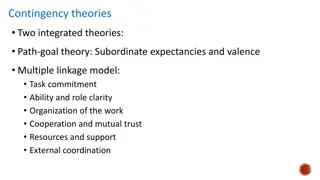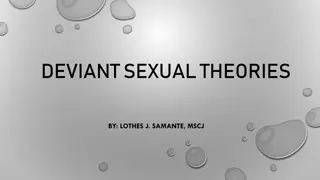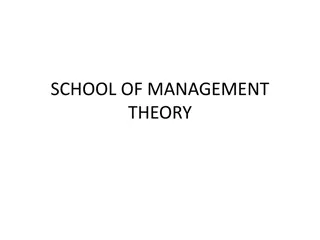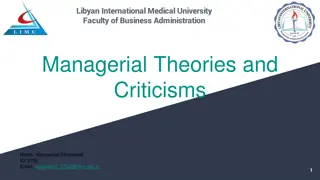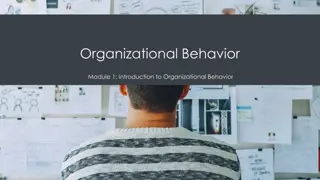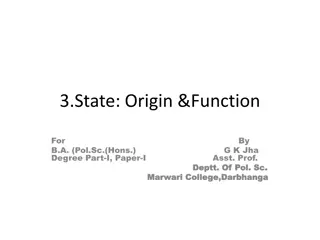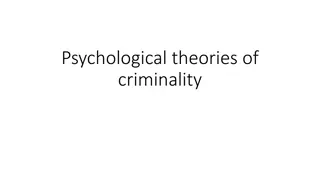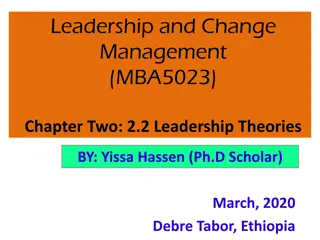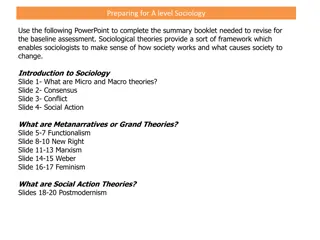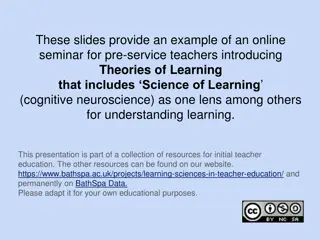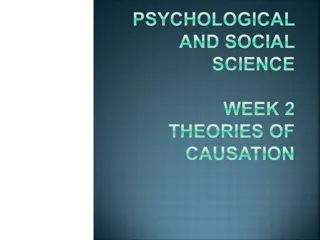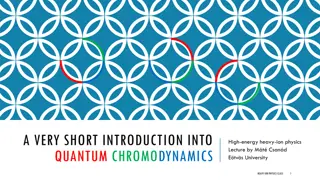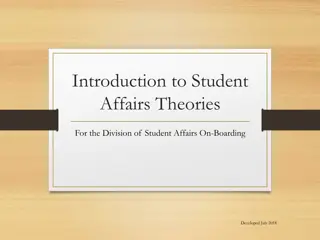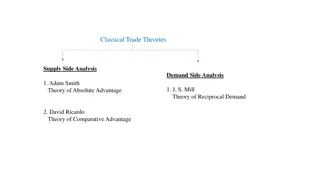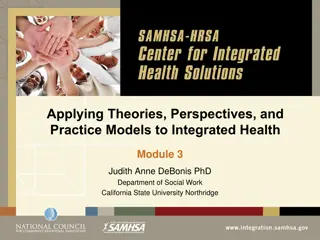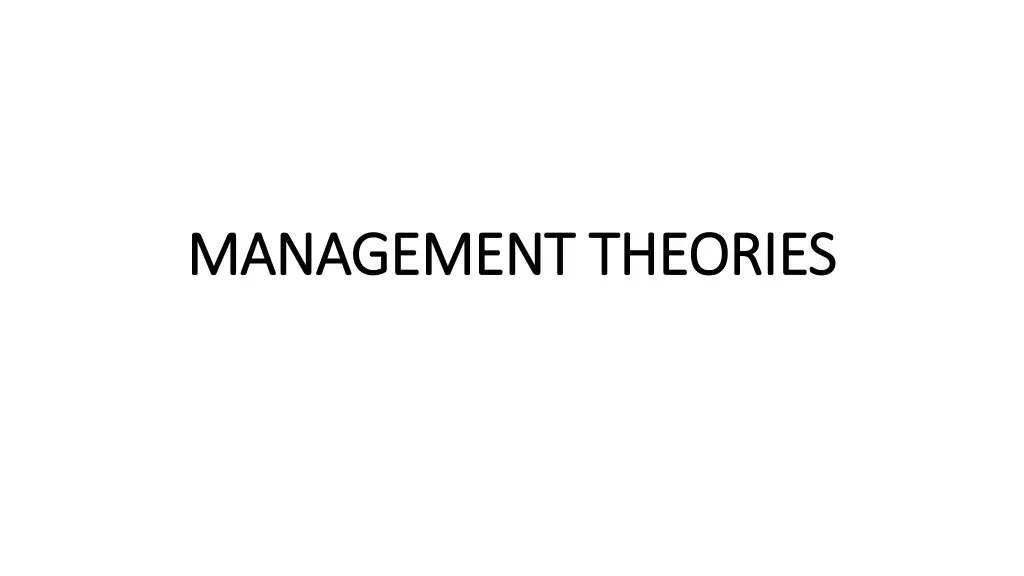
Management Theories Overview
Explore the evolution of management theories including Scientific Management Theory and Human Relations-Based Management. Learn how management principles have shaped the way work is done through others and the impact on efficiency in various industries.
Download Presentation

Please find below an Image/Link to download the presentation.
The content on the website is provided AS IS for your information and personal use only. It may not be sold, licensed, or shared on other websites without obtaining consent from the author. If you encounter any issues during the download, it is possible that the publisher has removed the file from their server.
You are allowed to download the files provided on this website for personal or commercial use, subject to the condition that they are used lawfully. All files are the property of their respective owners.
The content on the website is provided AS IS for your information and personal use only. It may not be sold, licensed, or shared on other websites without obtaining consent from the author.
E N D
Presentation Transcript
MANAGEMENT THEORIES MANAGEMENT THEORIES
What Is Management? The essence of management is getting work done through others. The classic definition of manage- ment is Henri Fayol s 1916 list of managerial tasks: planning, organizing, commanding, coordinating, and controlling the work of a group of employees (Wren, 1972).
1. Scientific Management Theory Almost 100 years ago, Frederick Taylor argued that most jobs could be done more efficiently if they were analyzed thoroughly (Lee, 1980; Locke, 1982). With a well-designed task and enough incentive to get the work done, workers could be more productive. For example, Taylor promoted the concept of paying people by the piece instead of by the hour. In health care, the equivalent would be by the number of patients bathed or vis- ited at home rather than by the number of hours worked. This would create an incentive to get the most work done in the least amount of time. Taylorism stresses that there is a best way to do a job. Usually, this is also the fastest way to do the job (Dantley, 2005).
The work is analyzed to improve efficiency. In health care, for example, there has been much discussion about the time it takes to bring patients to radiology or to physical therapy versus bringing the technician or therapist to the patient. Eliminating excess staff or increasing the productivity of remaining employees is also based on this kind of thinking.
Nurse managers who use the principles of scientific management will pay particular attention to the type of assessments and treatments done on the unit, the equipment needed to do this efficiently, and the strategies that would facilitate efficient accomplishment of these tasks. Typically, these nurse managers keep careful records of the amount of work accomplished and reward those who accomplish the most.
2. Human RelationsBased Management McGregor s theories X and Y provide a good example of the difference between scientific management and human relations based management. Theory X, said McGregor (1960), reflects a com- mon attitude among managers that most people do not want to work very hard and that the manager s job is to make sure that they do work hard. To accomplish this, according to Theory X, a manager needs to employ strict rules, constant supervision, and the threat of punishment (reprimands, withheld raises, and threats of job loss) to create industrious, conscientious workers.
Theory Y, which McGregor preferred, is the opposite viewpoint. Theory Y managers believe that the work itself can be motivating and that peo- ple will work hard if their managers provide a supportive environment. A Theory Y manager emphasizes guidance rather than control, development rather than close supervision, and reward rather than punishment. A Theory Y nurse manager is concerned with keeping employee morale as high as possible, assuming that satisfied, motivated employees will do the best work. Employees attitudes, opinions, hopes, and fears are important to this type of nurse manager. Considerable effort is expended to work out conflicts and promote mutual understanding to pro- vide an environment in which people can do their best work.
3. Systems Management Theory Systems management offers an alternative approach to the planning and management of organizations. The systems management theory proposes that businesses, like the human body, consists of multiple components that work harmoniously so that the larger system can function optimally. According to the theory, the success of an organization depends on several key elements: synergy, interdependence, and interrelations between various subsystems.
Employees are one of the most important components of a company. Other elements crucial to the success of a business are departments, workgroups, and business units. In practice, managers are required to evaluate patterns and events in their companies so as to determine the best management approach. This way, they are able to collaborate on different programs so that they can work as a collective whole rather than as isolated units.
4.Contingency Management Theory The main concept behind the contingency management theory is that no one management approach suits every organization. There are several external and internal factors that will ultimately affect the chosen management approach. The contingency theory identifies three variables that are likely to influence an organization s structure: the size of an organization, technology being employed, and style of leadership.
Fred Fiedler is the theorist behind the contingency management theory. Fiedler proposed that the traits of a leader were directly related to how effectively he led. According to Fiedler s theory, there s a set of leadership traits handy for every kind of situation. It means that a leader must be flexible enough to adapt to the changing environment. The contingency management theory can be summed up as follows: There is no one specific technique for managing an organization. A leader should be quick to identify the particular management style suitable for a particular situation. The primary component of Fiedler s contingency theory is LPC the least preferred co-worker scale. LPC is used to assess how well oriented a manager is.
QUALITIES OF AN EFFECTIVE MANAGER Leadership Clinical expertise Business sense.



